
Bridging Prague Award - competition results
An international architectural competition sought the form of the waterfronts in Prague – the most interesting one was found in Canada!
Prague, May 29, 2012 – The winner of the international conceptual architectural competition, announced as part of the reSITE festival, is Canadian architect Pete North. The expert jury of the two-round competition selected from more than 100 submitted proposals from around the world. “The proposal concentrates on enhancing the natural character of places near the river, where it is logical and feasible. It seeks to create a synergy between park locations and the river, aiming to connect them into a logical chain of interrelated spaces,” stated the jury's reasoning for the best among the 19 finalists. A total of 662 studios from all over the world registered for the competition.
The competition was organized by the reSITE Festival, the Architectural Institute in Prague (ARCHIP), and Skanska. International interdisciplinary teams competed for prizes of 3000, 2000, and 1000 euros donated by Skanska. In their designs, they processed the most suitable solutions for the Vltava waterfront and its immediate surroundings, delineated by two bridges – the Railway Bridge from the south and the Libeň Bridge from the north. This long stretch of the river has a very diverse character and quality on both banks, giving competitors the opportunity to select and develop a whole range of places or areas. The designs were to harness the existing potential of the river, define the connection between the river and the metropolis – and aim for the creation of attractive public spaces of an appropriate scale, enlivened by a variety of activities.
Petr Pištěk, vice-rector of ARCHIP, the organizer of the competition, says: “With the help of an international conceptual competition, we wanted to take a broader look at the Vltava and gain new ideas for its connection with Prague, which we succeeded in doing. According to the authors of the best proposals, the expansive water surface in the city has great potential – but its full utilization lacks an overall and clear concept. Relatively small adjustments could significantly revitalize the river. These could connect different parts of the waterfront, make the Vltava accessible for culture and sports – or conversely, support natural locations. The results should not only serve as an impetus for public and political discussion – but also as a starting point for further, more precisely focused competitions.”
Prizes for the competition were donated by the main sponsor – Skanska. They decided to support it for several reasons. “Environmental protection and reducing the risk of negative impacts from construction activity are integral parts of Skanska's corporate strategy,” says Lucie Nováková from Skanska. “reSITE motivates the general public and experts to reflect on the current appearance of the city. It points out that everything can be done sensitively and within the principles of sustainable development. That is also our goal. Therefore, we consider the cooperation between Skanska and reSITE meaningful and highly beneficial in both directions,” adds Lucie Nováková on behalf of the main sponsor.
The international competition was anonymous, two-round, open to all interested parties regardless of age or profession. Individuals, studios, and teams could participate. Two juries evaluated the contest proposals, with a jury composed of Igor Kovačević (CZ), Adam Gebrian (CZ), Ondřej Hofmeister (CZ), Henry Hanson (US), and Štěpán Špoula (CZ) selecting 19 finalists from the submitted proposals. The main international jury then evaluated the three best proposals and awarded two honorable mentions during the reSITE festival. The jury included Jakub Cigler (CZ), Lisa Diedrich (DE), Adam Gebrian (CZ), Alexandros Washburn (US), and Michael Rink (DE).
FROM THE JURY’S EVALUATION
First Place - The River Works: Pete North, Canada
The proposal concentrates on enhancing the natural character of places near the river, where it is logical and feasible. It seeks to create a synergy between park locations and the Vltava, aiming to connect them into a logical chain of interrelated spaces. It builds practically nothing new, but tries to strengthen the recreational character of the spaces by the river while also dealing more naturally with possible future flooding. It envisions the future of the Negrelli Viaduct in the form of New York’s Highline and proposes a connection with Stromovka and the Exhibition Grounds by modifying the space of the former Prague-Bubny station. It understands Štvanice as an unbuilt oasis in the middle of the city.
Second Place: Bring your ideas to Vltava: Juras Lasovský, Koen Hezemans, Netherlands
The opposite of theoretical visions. The idea of boats with practical content operated by local communities that can help with both the physical transformation of the location and its short-term revival through cultural programs.
Third Place: Prague and Vltava: Martin Špičák, Nikola Dočekal, Jiří Deyl, Czech Republic
The proposal clearly demonstrates an excellent knowledge of the environment and proposes a series of small, almost imperceptible interventions that could have a significant impact. This is urban acupuncture in the best sense of the term. It is based on the assumption that the space of the river and its immediate surroundings is beautiful and rich enough that it would be sufficient to enhance its character using only minimal interventions. The jury appreciates the sensitivity and poetry of these interventions.
Honorable Mentions
Honorable mentions were awarded to two projects that did not propose comprehensive solutions for the river and its integration into the city but both focused on a clear and understandable message.
Honorable Mention: The Frozen River: Eduard Seibert, Czech Republic
Due to the Vltava cascade, the river is relatively cold in summer and warm in winter, so it does not freeze. The proposal presents the idea of modifying the Vltava cascade so that the river freezes for a longer period in winter. It perceives it as an extensive public space whose use is lower than it could be. The freezing of the Vltava becomes a means to further utilize its potential.
Honorable Mention: Prague 0: Ivan Boroš, Juraj Calaj, Lenka Míková, Vítězslav Danda, Czech Republic
The authors propose to make the Vltava a separate urban part named Prague 0. By doing so, they reflect the fact that Prague was formed on the Vltava and that it is therefore the reason and beginning of further development. They correctly point out the complexity and vagueness of permitting various activities on the river. The jury appreciated that the authors clearly pointed out that physical changes must be preceded by administrative changes.
More information >
Prague, May 29, 2012 – The winner of the international conceptual architectural competition, announced as part of the reSITE festival, is Canadian architect Pete North. The expert jury of the two-round competition selected from more than 100 submitted proposals from around the world. “The proposal concentrates on enhancing the natural character of places near the river, where it is logical and feasible. It seeks to create a synergy between park locations and the river, aiming to connect them into a logical chain of interrelated spaces,” stated the jury's reasoning for the best among the 19 finalists. A total of 662 studios from all over the world registered for the competition.
The competition was organized by the reSITE Festival, the Architectural Institute in Prague (ARCHIP), and Skanska. International interdisciplinary teams competed for prizes of 3000, 2000, and 1000 euros donated by Skanska. In their designs, they processed the most suitable solutions for the Vltava waterfront and its immediate surroundings, delineated by two bridges – the Railway Bridge from the south and the Libeň Bridge from the north. This long stretch of the river has a very diverse character and quality on both banks, giving competitors the opportunity to select and develop a whole range of places or areas. The designs were to harness the existing potential of the river, define the connection between the river and the metropolis – and aim for the creation of attractive public spaces of an appropriate scale, enlivened by a variety of activities.
Petr Pištěk, vice-rector of ARCHIP, the organizer of the competition, says: “With the help of an international conceptual competition, we wanted to take a broader look at the Vltava and gain new ideas for its connection with Prague, which we succeeded in doing. According to the authors of the best proposals, the expansive water surface in the city has great potential – but its full utilization lacks an overall and clear concept. Relatively small adjustments could significantly revitalize the river. These could connect different parts of the waterfront, make the Vltava accessible for culture and sports – or conversely, support natural locations. The results should not only serve as an impetus for public and political discussion – but also as a starting point for further, more precisely focused competitions.”
Prizes for the competition were donated by the main sponsor – Skanska. They decided to support it for several reasons. “Environmental protection and reducing the risk of negative impacts from construction activity are integral parts of Skanska's corporate strategy,” says Lucie Nováková from Skanska. “reSITE motivates the general public and experts to reflect on the current appearance of the city. It points out that everything can be done sensitively and within the principles of sustainable development. That is also our goal. Therefore, we consider the cooperation between Skanska and reSITE meaningful and highly beneficial in both directions,” adds Lucie Nováková on behalf of the main sponsor.
The international competition was anonymous, two-round, open to all interested parties regardless of age or profession. Individuals, studios, and teams could participate. Two juries evaluated the contest proposals, with a jury composed of Igor Kovačević (CZ), Adam Gebrian (CZ), Ondřej Hofmeister (CZ), Henry Hanson (US), and Štěpán Špoula (CZ) selecting 19 finalists from the submitted proposals. The main international jury then evaluated the three best proposals and awarded two honorable mentions during the reSITE festival. The jury included Jakub Cigler (CZ), Lisa Diedrich (DE), Adam Gebrian (CZ), Alexandros Washburn (US), and Michael Rink (DE).
FROM THE JURY’S EVALUATION
First Place - The River Works: Pete North, Canada
The proposal concentrates on enhancing the natural character of places near the river, where it is logical and feasible. It seeks to create a synergy between park locations and the Vltava, aiming to connect them into a logical chain of interrelated spaces. It builds practically nothing new, but tries to strengthen the recreational character of the spaces by the river while also dealing more naturally with possible future flooding. It envisions the future of the Negrelli Viaduct in the form of New York’s Highline and proposes a connection with Stromovka and the Exhibition Grounds by modifying the space of the former Prague-Bubny station. It understands Štvanice as an unbuilt oasis in the middle of the city.
Second Place: Bring your ideas to Vltava: Juras Lasovský, Koen Hezemans, Netherlands
The opposite of theoretical visions. The idea of boats with practical content operated by local communities that can help with both the physical transformation of the location and its short-term revival through cultural programs.
Third Place: Prague and Vltava: Martin Špičák, Nikola Dočekal, Jiří Deyl, Czech Republic
The proposal clearly demonstrates an excellent knowledge of the environment and proposes a series of small, almost imperceptible interventions that could have a significant impact. This is urban acupuncture in the best sense of the term. It is based on the assumption that the space of the river and its immediate surroundings is beautiful and rich enough that it would be sufficient to enhance its character using only minimal interventions. The jury appreciates the sensitivity and poetry of these interventions.
Honorable Mentions
Honorable mentions were awarded to two projects that did not propose comprehensive solutions for the river and its integration into the city but both focused on a clear and understandable message.
Honorable Mention: The Frozen River: Eduard Seibert, Czech Republic
Due to the Vltava cascade, the river is relatively cold in summer and warm in winter, so it does not freeze. The proposal presents the idea of modifying the Vltava cascade so that the river freezes for a longer period in winter. It perceives it as an extensive public space whose use is lower than it could be. The freezing of the Vltava becomes a means to further utilize its potential.
Honorable Mention: Prague 0: Ivan Boroš, Juraj Calaj, Lenka Míková, Vítězslav Danda, Czech Republic
The authors propose to make the Vltava a separate urban part named Prague 0. By doing so, they reflect the fact that Prague was formed on the Vltava and that it is therefore the reason and beginning of further development. They correctly point out the complexity and vagueness of permitting various activities on the river. The jury appreciated that the authors clearly pointed out that physical changes must be preceded by administrative changes.
More information >
The English translation is powered by AI tool. Switch to Czech to view the original text source.
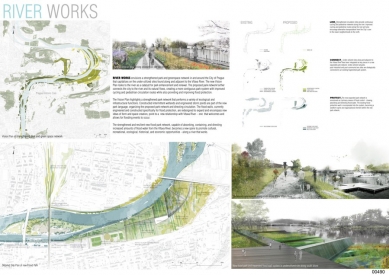
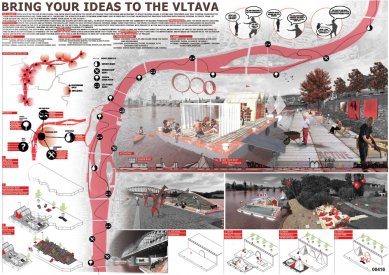
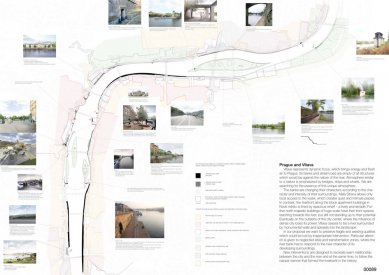
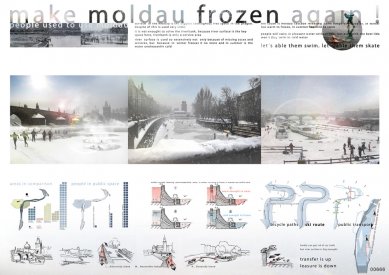
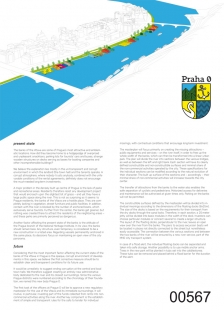
1 comment
add comment
Subject
Author
Date
SKANSKA resp Bakala to myslí s Prahou tak dobře....
VH
01.06.12 10:25
show all comments











